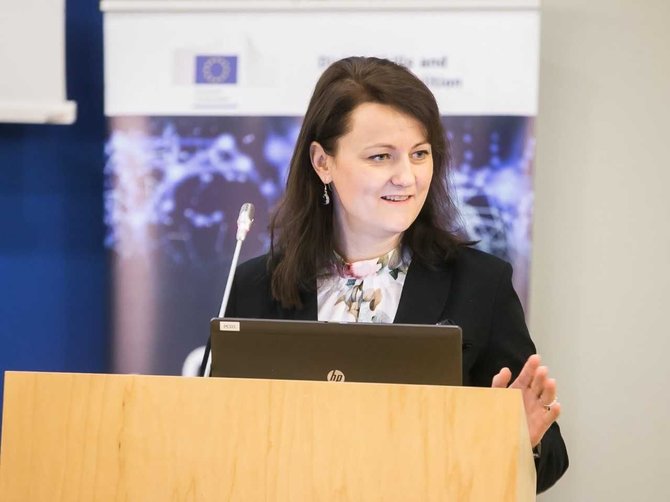According to Dr Renata Danielienė, lecturer and IT expert at the Kaunas Faculty of Vilnius University and the Cyberthon 2021 competition, the number of cyber attacks is growing every year. This year, their number was further increased by the quarantine, when most companies moved their activities into the virtual space and employees began working from home, meaning that less-protected personal computers were used for professional activities.
Phishing – the Most Popular Fraud Technique
Europol 2020 statistics reveal that social engineering and phishing remain one of the main threats posed by cyber attacks.
“Scammers typically use e-mail, SMS, and messages on social networks to access personal data. Such messages often contain a link that the recipient should click to resolve an alleged problem or to view some relevant information. They may also contain attached documents or archived files. By opening or installing documents or other files sent by scammers, the user can infect their device with malware that can collect their personal data or help the scammer to take control of the device,” said the IT expert.
Scammers rely on social engineering and manipulation, where the victim takes certain actions without a moment’s hesitation following a hasty decision. Different social engineering techniques range from calling an organisation, when the caller pretends to be a technician to gain access to the information systems, to electronic messaging. Cyber criminals often use phishing, a fraudulent technique, which has accounted for the majority of all social engineering attacks in recent years. The main purpose of these attacks is to extract personal information in one way or another, such as e-mail logins, social media accounts, credit card details or other financial information.
“If the attackers can devote a lot of resources and time to their malicious activity, where the organisation they are trying to hack has extremely valuable and confidential information, they sometimes use more sophisticated approaches such as infiltrating criminals into the organisation,” explained Dr Danielienė.
Knowledge of Criminals is Keeping Pace with Improved Technologies
As communication has become virtual during the pandemic, cyber scammers enjoyed the even greater opportunities that opened up, allowing them not only to attack people by e-mail but also to entice them into their traps in other ways. Perpetrators have adapted to the current situation and introduced some improvements to their tools. Nonetheless, the main motive for the cyber criminals has remained the same: financial gain.
According to Dr Danielienė, fraudsters often use human emotions such as fear or curiosity while creating messages about current events during a specific period. For example, cyber criminals often send e-mail messages claiming to provide relevant information about COVID-19. By pretending to be representatives of the WHO or other health organisations, the swindlers may attach documents to an e-mail that can infect the device with malware when opened, or the message may contain a link to a website where, according to the fraudster, the recipient can get the latest information about the pandemic, sign up for a free vaccination, and so on. “When a person clicks on the link to a website in a phishing e-mail, he or she is asked to connect to a system that looks normal. The person then fills in the fields, unwittingly providing either mail system login or financial details,” said Dr Danielienė. The expert added that in the past, fraudulent messages could often be identified by grammatical and spelling errors, but those sent nowadays contain no or extremely few errors, which encourages people to trust the message and the fraudulent information they have received.
The IT expert pointed out that letters from criminals look very similar to those from real institutions, i.e. they may use company logos and colours, while the contact details, such as e-mail addresses, may differ only slightly from the ones used by real organisations. It is therefore important to pay attention to these symbols: for example, there may be an unusual suffix at the end of an e-mail that the recipient may overlook (such as ).
“One of the most recent examples of fraudulent e-mails using an organisation’s name was directed against Luminor Bank. The bank’s customers received false messages with payment information attached. In this way, the cyber attackers spread malware and tried to hack into the confidential information of the bank’s customers,” recalled Dr Danielienė. She also gave another example of cyber fraud, where the name of Vilnius University was used as the bait: “Malicious messages with an attached file and a request to open it were sent to members of the university community. The fraudulent message used the university’s logo and the details of a real employee, so the message looked genuine at first glance.”
Another attribute that can help to identify fraudulent messages is that they often contain a link that appears to connect to an institution’s website. By clicking on such a link, a fake site designed by the fraudsters is opened that looks identical to the original one, where even the web address can be very similar to that of the real site. Sometimes just one letter is replaced with another for the purpose of deception. For example, the letter “l” in www.adresas.lt can be replaced with “i”, so the difference in the deceptive web address www.adresas.it is difficult to notice.
Anyone Can Fall Victim to Attacks
Cyber attacks can affect anyone. “Scammers can send e-mails or messages to existing addresses and contacts that may be publicly available on the internet, or can be sold on the black market as a result of cyber incidents. The target of a fraudulent phishing e-mail can be either a company employee or an ordinary citizen. This technique does not require much effort or resources, and it is likely that someone will swallow the bait, because the perpetrators encourage their victims to take certain actions. Such messages often call for haste or intimidate the victim – suggesting that a failure to follow the instructions will mean that he or she may lose access to a system or their actions on that system will be restricted. Sometimes the scammers use a more enticing lure and offer incredible discounts or unexpected gains in their messages,” warned the cyber security expert about the potential dangers.
Before attacking, some of these criminals gather information about the prospective victim, who may be a company executive or financier. After a careful analysis, the perpetrator then sends a mail to that specific person with an urgent and insistent request, such as a company manager asking a financier to make an urgent transfer.
Information Literacy Helps to Protect against Cyber Attacks
Cyber security professionals can help us to protect ourselves against the scams that are increasingly spreading across the online world. If we pay attention to their recommendations, we can learn to refrain from hasty actions, critically evaluate the information we receive, and in this way protect our important and sensitive data.
“Before circulating any photos on social media, people should think twice about whether these pictures contain personal information such as a home address, car registration number, and so on. In addition, employers are advised to organise cyber incident simulations that can identify the most vulnerable points in an organisation and to conduct regular cyber security training for their employees,” Dr Danielienė advised.
It is believed that artificial intelligence, which has been recently introduced to cyber security, will be able to protect us from cyber threats even better than the people working in that field. Through machine learning, artificial intelligence is already used in both investigating and detecting intrusions. But the question always remains: can we be sure that the cyber criminals will not learn to take advantage of artificial intelligence tools?













